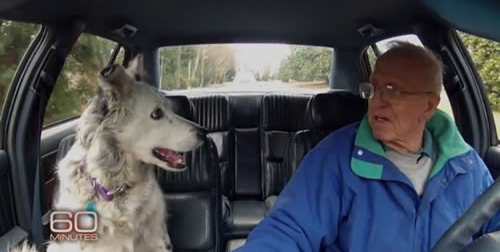The Smartest Dog in the World
“Smartest Dog in the World” is quite a claim. Chaser seems to back it up though. In case you missed his appearance on CBS’s 60 Minutes you can view it here http://www.cbs.com/shows/60_minutes/video/cucSLY74AU2N8tLukKHWqFnN1JluvEjw/the-smartest-dog-in-the-world/
Psychology professor, John Pilley, Chaser’s companion, proves the natural communication ability of dogs. Chaser understands over 1,000 toy names. Pilley has been working with Chaser up to 5 hours a day since puppyhood. His conclusions about dog intelligence comports with my observations from working with dogs for over 30 years.
In thinking about the 60 Minutes segment a couple of Pilley’s points really hit home for me. They are worthy of elaboration as you apply them to your family dog and work to build your companionship relationship. We don’t have 5 hours a day to teach our dogs elaborate toy tricks, but the principles are the same.
- Using games to teach. I’ve long used the biscuit toss game to teach and reinforce several important commands (Stay, Pick it Up, Drop It, Get Back There, Good Dog, Bad Dog, etc.). The biscuit, as a reward, isn’t the motivation. I’ve never used treats that way. Traditional trainers believe that reward and punishment is the only way to create a desired behavioral response. Think of the circus trainer with a pocket full of treats who uses bribery to make the performance happen on cue. That’s insulting to the intellectual capacity of the dog. When I play the biscuit toss game with Chimo, she knows from the beginning that regardless of what happens she will wind up with the biscuit. It’s just a fun activity and if she learns something along the way and can make a communication connection, all the better. It’s a point of satisfaction and fulfillment to her.
- Combining words to create new meanings. Pilley is all about connecting names to “ball”, for example, to teach Chaser that ball is a family of toys. He also uses commands like “paw” and “take” along with toy names to create new meanings. This is a great technique that can really work for teaching your dog. In The Heart of Your Dog I explain families of commands where new commands are built around commands already learned. When combination or sequence of commands is understood, a new unique command can be gradually substituted to create a simple command containing the compound meaning. The example I like to use is stringing together learned commands, such as Upstairs, Pick It Up, Bring It Here, and Drop It, and evolving that into the one-word command of Slippers, which packs all those meanings together.
Unlocking your dog’s potential is a worthy journey and Pilley’s contributions to the science of canine brains and behavior back that up. Meanwhile the parallel techniques described in The Heart of Your Dog have a very different aim – building a deep relationship and satisfying your dog’s higher unmet needs. While communication is one of the highest needs, it’s important to keep in mind that learning hundreds of toy names is impressive, but it is also inappropriate and pointless for the family dog. We need to find better ways to employ what we now know about dogs. I am sure Pilley would agree that this shouldn’t be about creating more talented circus dogs.

Comments are closed.